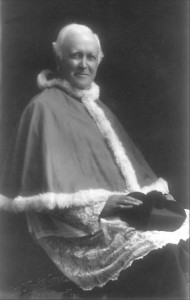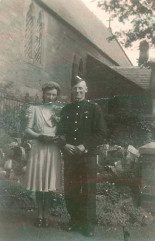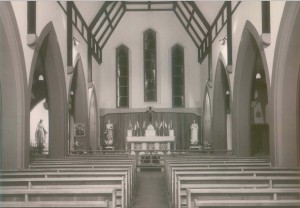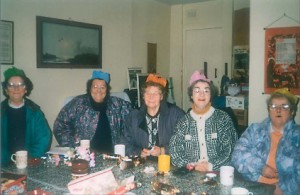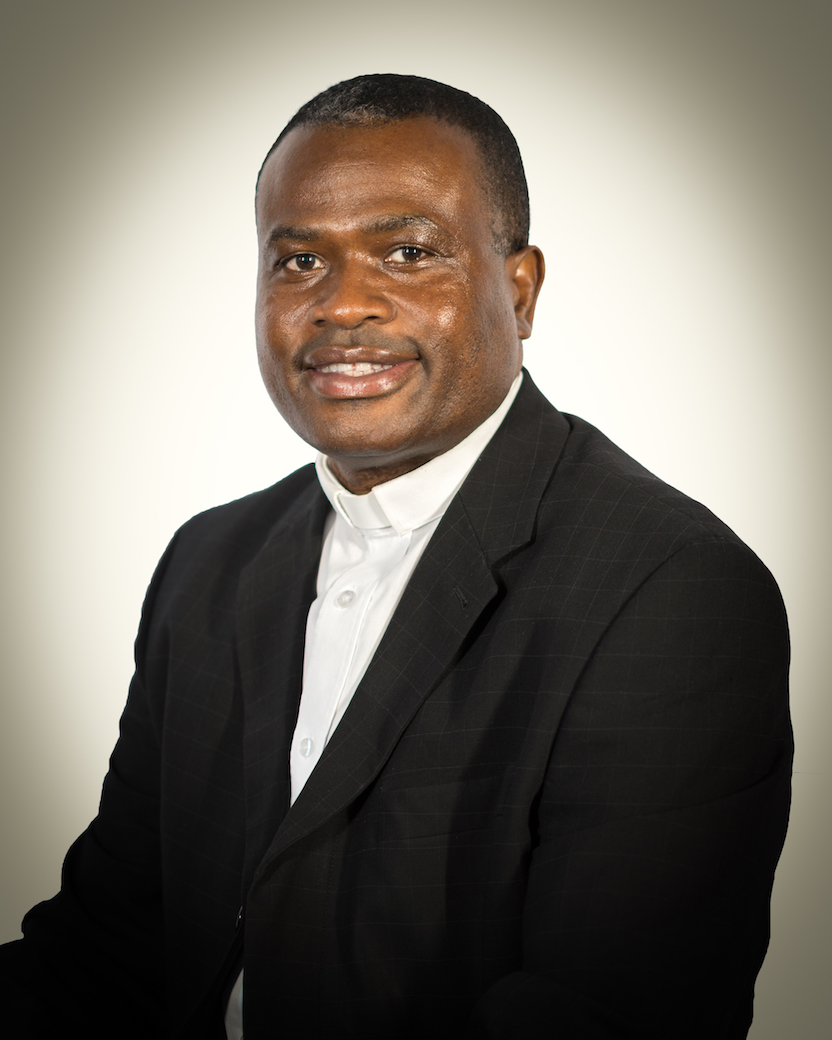The vision of the Reverend James Mackay began to take shape when an appeal for funding resulted in his purchase of land in Constable Lane or Street, (now Bank Street) on which two houses were built. One was rented out, along with the ground floor of the other, while the remaining floor was fitted up as a temporary chapel. On 26th November 1837, Mass was celebrated within the chapel on the upper floor for the first time, and gradually the numbers of the little congregation increased.
In October 1849, the Rev. John Carmont was appointed as resident priest. Overcoming many difficulties, and with the financial assistance of Mr and Mrs Trotter of Woodhill, he was able to purchase further ground, on which St Stephen’s Church was built. The building was designed by W. E. Pugin, who reversed the original plan, and placed the entrance towards John Street rather than Bank Street. Mass was celebrated within the Church before the end of 1855, with the solemn opening taking place on 13th January, 1856.
In 1906 the Church celebrated its Golden Jubilee, under the pastoral care of Canon John Malcolm. The church was painted and re-decorated, and an organ purchased, half the cost of which was met by the late Andrew Carnegie. Also during Canon Malcolm’s 28 year charge, a heating system was introduced, and a new Presbytery built. By 1917, when Canon Malcolm moved on, the Parish was self-supporting, and free of debt, thanks to the generosity of benefactors.
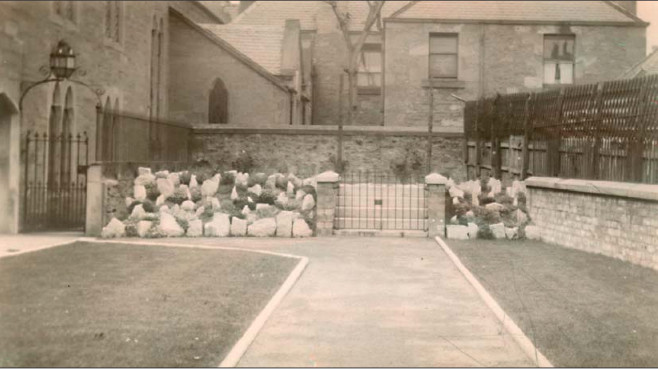
Canon Malcolm was succeeded by Father, later Canon Walter Stretch. He remained in St Stephen’s until his retiral in 1951, dying a month later. Among many gifts donated during his incumbency was a twelve figure crib, donated in memory of a former organist, Lizzie McGregor, by her daughter, Miss Smith of Portobello. The garden at the entrance to the Church seen in many photographs donated by parishioners, was also established during this period.
Mrs Ida Moran grew up in Coupar Angus, where there was no Catholic Church. She remembers as a six year old, walking with her mother and brother to the nine o’clock Children’s Mass at St Stephen’s on a Sunday morning. Her family had a pew at the first pillar, near the vestry door, for which they paid half a crown (twelve and a half pence) a year.
Being unable to attend the Catholic school, Ida received Sacramental instruction on a Saturday morning from Canon Stretch, and, as she grew older, took messages to and from Bishop Toner in Dundee. The half fare on the train was seven pence halfpenny, so it made good economic sense to send the young Ida as messenger. She thinks that perhaps the box she collected contained hosts, as it was wrapped in brown paper, and sealed with a red seal. As well as walking up and back in the morning for Mass, when she was old enough, Ida walked up for Benediction at 6 o’clock on a Sunday evening. Along with many of the girls of the parish, she attended the “Children of Mary”, having her veil pinned on in the vestry by Canon Stretch’s housekeeper, and then walked back to Coupar Angus with her friends. They thought nothing of it. It was just what they did!
Canon Stretch also took a lively interest in the social and moral life of the youth of the parish, and did not hesitate to call them aside, telling them to get home, if he had doubts about their company or behaviour!
In one instance at least, he was also called upon to speak to some youngsters who had been caught stealing strawberries from a garden in David Street. No one thought anything of his involvement with the youngsters. It was just what he did!
In 1936, Mrs Yolanda Visocchi came to St Stephen’s as a young bride. Although she found the parishioners very friendly, it was strange for her coming from St Mary’s, Lochee, and as a busy young wife and mother, she felt that not much was happening in the parish before the war. Evidently there were social events during the war, as Marty Moran used to walk his young lady, Ida, to the bus after the concerts. When Marty had his army medical in 1940, he knew that “call-up” was imminent. Canon Stretch very quickly contacted the Bishop for a special dispensation, and Marty married Ida within the fortnight.
Around the same time, after the bombing of Clydebank, the Sweeney family, with a young Ann, moved to Blairgowrie, living initially with an aunt, until the family moved to the foot of John Street. Ann remembers well the nine o’clock Children’s Mass, where Miss Donnelly, the Head teacher of St Stephen’s school, stood in front of the rows of children, struck her tuning fork, and “away they went.”
Later, Mary Davidson played the organ, and so the choir began to develop. The Davidsons lived in one of the church properties in Bank Street, and had a door from their garden through “The Golden Steps” leading into the Boiler House at the back of the Church. Old Mr Davidson cleaned the Church, and was also an altar server well into old age.
As the 100 year milestone approached, St Stephen’s underwent extensive renovation, instigated by Father, soon to become Canon O’Donoghue. During the renovations, the pews were taken out, and replaced with pews of Japanese oak. The old pews, complete with space for a name card denoting the “tenant” of the pew, went into the Stand at Blairgowrie Junior Football Club in Davie Park. These were later removed, when the “Stand” became just that, and there was no seating.
Mrs Visocchi remembers Canon O’Donoghue as “the one who livened things up” and the Parish responded to his leadership with enthusiasm. The modernisation was not without cost, and during this time St Stephen’s Parish was even more active, holding Jumble Sales, Fetes, Concerts and Social Gatherings, to bring in funds to pay for the ambitious scheme. Canon O’Donoghue was popular in the town, and the townspeople responded well to the congregation’s fund-raising efforts. A newspaper report of one such event in August 1952 described the impressive platform party, and outlined the activities and heavily laden stalls provided by parishioners and well-wishers. The sale realised £300, a substantial amount for that time, indicative of the strong support given by and to the Parish.
It was during these renovations that access to the hall was changed, and tarmac was laid at the entrance to the church. During the renovations, the organ too was modernised, now powered by electricity.
Some members of the congregation, however, remember when the power was supplied by the efforts of young boys, whose energy, or attention, would wane, and who then had to pump the blower furiously before the music died out altogether!
Mrs Gordon, (David’s mother), succeeded Mary Davidson, and played the organ for 28 years.
It was almost a full-time job, with Choir Practice on a Wednesday night, and Benediction on a Sunday as well as playing for Mass, and in spite of her years of experience, Mrs Gordon was always nervous before she played, and made sure she had time to practise before the service started! After the Centenary Mass “Many were the compliments paid to Mrs Gordon and the choir for a beautiful and devotional rendering of the sacred music.” (Blairgowrie Advertiser).
Canon O’Donoghue was succeeded by Father, later Canon, Kevin Smyth. The first marriage he conducted in St Stephen’s was that of Ida and David Gordon. Long before she met David, Ida’s Saturday evening memories of St Stephen’s were of a darkened church, where her Catholic friend disappeared to go to Confession! (Ida later received instruction, and became a Catholic herself, before her marriage to David.)
Canon Smyth is remembered with great affection by parishioners, whom he served well even after his retirement. In spite of the extensive renovations for the centenary, more money was required for the on-going work necessary for the upkeep and improvement of the church. Almost £2000 was raised and spent on improvements, including the continuation of the tarmac outside the church to provide a car parking facility, flooring in front of the altar, and the purchase of a new chalice. The people of St Stephen’s continued to work together, giving o their time and money to support the parish.
During the Berry Season, the church was “packed to the rafters”. Parishioners remember a family of thirteen children who bought their clothes at the jumble sale to wear at “The Berries”, but on a Sunday, they were immaculately turned out for Mass.
One lad was remembered for the number of books he bought! People came from Glasgow and the west, as well as from Dundee for “The Berries”, and were very supportive of the work of the parish. Nowadays the congregation swells during the Berry-picking season with the young students from Poland and the Czech Republic, many of whom remain in the area.
Many changes occurred over the years, not only in the Parish, but, after Vatican II, throughout the whole Catholic Church. One change the parishioners fought against was the removal of the altar rails. The “Sanctuary” was indeed a holy place. Seemingly, only married ladies were allowed behind the altar rails, and all cleaning of the area was done “on your knees, and wearing a scarf on your head.” A meeting was held, and the Parish voted to keep the altar rails. However, in spite of this democratic vote, some time later, parishioners arrived for morning Mass to find the rails had gone! There really was no choice, as the decision had come “from above.”
What of the children of the Parish? The afore-mentioned Miss Donnelly noted those who had not attended the Children’s Mass, and duly dealt with them on a Monday morning. Children were expected to be seen and not heard, and parishioners remember, “The person whose child is making a noise and distracting people from their prayers, please go home!” They did, and they came back, and the children grew up. Now children are welcomed into the Church, and the Children’s Liturgy ensures that children leave Sunday Mass knowing what the message of the Gospel was. The school is now seen as an integral part of the Parish community, with the Parish sharing in Family and class Masses, as well as Sacramental Celebrations.
Throughout its long history, the people of St Stephen’s have continued to raise money, holding Jumble sales, sales of work, (now a thing of the past), Bingo evenings (still popular!) and supporting the Missions and SCIAF. Some people also remember a teenage Ida Moran on her bicycle, collecting a shilling a month from the Irish workers in the bothies, and from Coupar Angus parishioners, for the fabric of the Church. If a month was missed, then it was two shillings the following month! The names and payments were recorded in a book, which she then took to Canon Stretch.
As congregations and priests have changed, so have the social and parochial gatherings. Each priest has brought his own strengths to the Parish, and has introduced or supported innovations to encourage the spiritual and temporal growth of St Stephen’s Church. The Union of Catholic Mothers, founded by Kay Quinn, flourished, and held many fund-raising events. Mrs Dinah Cameron was Diocesan, and then National Representative and Ida Moran described how she and Mrs Cameron put on a concert “The Seasons of the Year” with the children from the school.
The stage was erected, free of charge, by Bob Bell the joiner, lighting was supplied, also free of charge, by Coupar’s, the electricians, and, between the performance and the raffle they “made quite a bit of money.” The U.C.M. gave way to the Guild, whose members continued to work hard, with fund-raising and social events. “The Over 60’s”, which later became “The Tuesday Club”, continued with sales of work, raffles, and so on, to raise funds for necessary refurbishment to the church. All have now, sadly, been disbanded.
A Parish Council was formed; Small Groups brought people together to renew their faith commitment, and lay people were encouraged to become more involved in the work of the parish, by reading at Mass, assisting as Eucharistic Ministers with the distribution of Holy Communion during Mass, and to the sick and housebound. On the 9th March, 1996, St Stephen’s joined the family of Tony Cousins in celebrating his ordination to the Permanent Diaconate, the first Deacon in the Parish.
Plans are afoot to revive the Parish Council, active in the time of Mgr Creegan, and Bishop Vincent’s “Duc in altum” is seeing the revival of Diocesan and Parochial involvement in the Church. The once thriving Youth Club declined, but our young people are again becoming involved, on a Parish and Diocesan level, and keep the parish up to date with reports in the Parish newsletter and in the “Dunkeld News”.
The inaugural meeting of St Stephen’s Conference of the Saint Vincent de Paul Society was held on 14th October, 1951, and presided over by Canon O’Donoghue. The Conference continues to thrive, being well supported financially by parishioners of St Stephen’s, St Mary’s, Coupar Angus, and St Luan’s, Alyth, which enables the brothers and sisters to carry on with charitable work in the area, and to support Twin Conferences in India and Africa. An annual event is the Christmas Lunch, attended by the elderly of the Parish, and hosted by the Conference and the Parish Priest.
Hugh Canon Sreenan retired as Parish Priest in September 2005. The concelebrated Mass was well attended by family, clergy, friends and well-wishers from the local community, and was followed by a reception in the Town Hall.
In January 2006, the new incumbent, Father Ian Mullen, concelebrated Mass to mark the 150th Anniversary of St Stephen’s with the Bishop of Dunkeld, the Right Rev. Vincent Logan.
In 2010 Fr Ian Mullen was succeeded by Father Jim Walls, until 2013, and then by Fr Gregory Umunna from 2013.
From late 2013 when Father Gregory Umunna Ph.D arrived as Parish Priest of St. Stephen’s, he consulted and undertook a survey of the weaknesses of the building and initiated a massive restoration work to the building, and associated elements, to make the Church wind and watertight, improve safety and stop the building falling into further disrepair.
Conservation and renewal were key as St. Stephen’s is a Category B-listed building dating from 1856 and is situated in the central area of the Blairgowrie Conservation Area.
What seemed to be isolated problems, due to what at first appeared to be limited dry rot, rising damp and water ingress in various parts of the building, were assessed and it was quickly realised that repair and renovation work was likely to be more extensive than at first suspected with the likelihood of resulting costs amounting to tens of thousands of pounds.
When the appeal for Heritage Lottery assistance was made, St Stephen’s was described as being a listed building at risk “primarily due to significant water ingress and rising damp”, and “the overall integrity of the building requires to be restored through an extensive repair process.” The application stressed that the work was both “essential and urgent”. The firm, James F Stephen, Architects, advised that intensive investigation would be necessary to assess just how much repair work would, in fact, be necessary. Dry rot and rising damp so often can be doing their insidious worst for years, well hidden from view. A pressing priority was ensuring the safety of the very fine stained-glass windows three of which are believed to be contemporary with the building of the church. These depict Mary, Joseph and the child Jesus, St Stephen and St Anne. Behind the stone altar there is a large triple stained-glass window made in the 1960s by the monks at Pluscarden Abbey depicting Jesus as the Good Shepherd. A further problem identified on the interior of the building was the use of non-breathable paint applied to the masonry framing the windows. The consequence of this has been that rainwater simply ran off this paint and into the harling, finding its way between Stripping and re-slating of principal elevation. the harling and sandstone beneath.
To summarise very briefly the initial assessment of the main external repair work required was:
- The roof – stripping and re-slating, the installation of breathable membrane; replacement of water-ingress-damaged sarking and rafters; inspection and replacement of all lead sheet/zinc gutters, flashings and weatherings; inspection and replacement of cast iron rain ware.
- The increase in rainfall in recent years, associated with climate change, is affecting the harling over all the building, showing evidence of likely water ingress and additional cast iron rainwear was required to remove this water, directing it from the roof to the below-ground drainage network. Within the church, from under the floor to the ceiling, dry rot, wet rot and rising damp were evident as was the need to repair the extensively cracked lath and plaster sections of the ceiling. The extent of the rot problem would, indeed, only become clear as the affected areas were stripped down.
- Chimney and roof repairs in progress. John Street gable shrouded in scaffold to enable masonry repairs.
- Plaster repairs being processed to knave ceiling. Skew stones removed from John Street gable. Access scaffold erected to allow high level roof repairs to principal elevation. Intrusive invasion to assess fabric condition.
- Timber roof repairs in progress. Tooling of window dressing on John Street gable. Preparation of replacement studs for installation on Sanctuary gable.
- Re-decoration of knave ceiling and Sanctuary gable.
- Re-decoration of organ gallery. If this remarkable classified building was to be saved for posterity, indeed even for its current congregation, the work required was not only essential but urgent.
- A total of Six hundred thousand pounds was estimated to complete this project.
With generous contributions from the Heritage Lottery Fund, Historic Scotland, the Diocese of Dunkeld and several Trusts confirmed, contracts to undertake the work were awarded and the vital work begun – and another page was turned in the story of St Stephen’s.
 At the completion and dedication of the historic restoration of St. Stephen’s Church, after three years of planning, sourcing of funds and execution, Fr. Gregory Umunna thanked Bishop Stephen Robson for the spiritually nourishing Dedicating ceremony and saluted the courage of parishioners who took up this challenge, volunteered selflessly and generously gave countless hours to this restoration work. He also thanked many others who took up many initiatives, raised funds and made donations towards this project. He singled out Mrs Evelyn Hood for her generous professional services to us in the area of an Audio-visio presentation of the restoration of St. Stephen’s, and Ian Kirkwood for his professional photographs and designs. Outstanding mention was made of the members of his Fabric Committee namely, Jim Graham, Alan Scot, Mike Coyle and Marion Duffy. Fr. Gregory said. ‘‘My special thanks go to them for their collaboration, tenacity, selfless commitment and dedication, from the commencement of this Church restoration work to its completion.’’ On behalf of the parish, he acknowledged and expressed our warmest gratitude to the Heritage Lottery Fund and Historic Environment Scotland for assisting us with a substantial grant to embark on the project. The same gratitude goes to the Garfield Weston Foundation, All Churches Trust, Scotland Churches Trust, Jimmy Cairncross Trust, Perth and Kinross Heritage Trust, The Baird Trust, Dalrymple Donaldson Fund and the Diocese of Dunkeld for their generosity and support. With all your support he said, ‘‘this major restoration project will help assure St. Stephen’s future for many generations to come. At the completion of this task, I salute and thank you all for a work well done!’’
At the completion and dedication of the historic restoration of St. Stephen’s Church, after three years of planning, sourcing of funds and execution, Fr. Gregory Umunna thanked Bishop Stephen Robson for the spiritually nourishing Dedicating ceremony and saluted the courage of parishioners who took up this challenge, volunteered selflessly and generously gave countless hours to this restoration work. He also thanked many others who took up many initiatives, raised funds and made donations towards this project. He singled out Mrs Evelyn Hood for her generous professional services to us in the area of an Audio-visio presentation of the restoration of St. Stephen’s, and Ian Kirkwood for his professional photographs and designs. Outstanding mention was made of the members of his Fabric Committee namely, Jim Graham, Alan Scot, Mike Coyle and Marion Duffy. Fr. Gregory said. ‘‘My special thanks go to them for their collaboration, tenacity, selfless commitment and dedication, from the commencement of this Church restoration work to its completion.’’ On behalf of the parish, he acknowledged and expressed our warmest gratitude to the Heritage Lottery Fund and Historic Environment Scotland for assisting us with a substantial grant to embark on the project. The same gratitude goes to the Garfield Weston Foundation, All Churches Trust, Scotland Churches Trust, Jimmy Cairncross Trust, Perth and Kinross Heritage Trust, The Baird Trust, Dalrymple Donaldson Fund and the Diocese of Dunkeld for their generosity and support. With all your support he said, ‘‘this major restoration project will help assure St. Stephen’s future for many generations to come. At the completion of this task, I salute and thank you all for a work well done!’’
 Part of the gains of the historic restoration of St. Stephen’s is the increasing number of families from the Philippines, Eastern Europeans significantly the Polish, Ukraine and Cech Republic, Latin American, and African origins. With this significant growth of the parish as a family of God Fr. Gregory Umunna initiated the Parish Diversity Day celebrated yearly during the summer.
Part of the gains of the historic restoration of St. Stephen’s is the increasing number of families from the Philippines, Eastern Europeans significantly the Polish, Ukraine and Cech Republic, Latin American, and African origins. With this significant growth of the parish as a family of God Fr. Gregory Umunna initiated the Parish Diversity Day celebrated yearly during the summer.
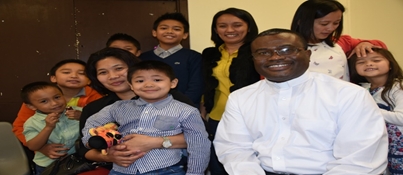 From this gift of multicultural presence and diversity he also nurtured a dedicated team of over twenty altar servers of the parish. In 2022, with the support of Fr. Gregory and the parishioners, these boys and girls hope to make a pilgrimage to St. Peter’s Basilica in Rome
From this gift of multicultural presence and diversity he also nurtured a dedicated team of over twenty altar servers of the parish. In 2022, with the support of Fr. Gregory and the parishioners, these boys and girls hope to make a pilgrimage to St. Peter’s Basilica in Rome
